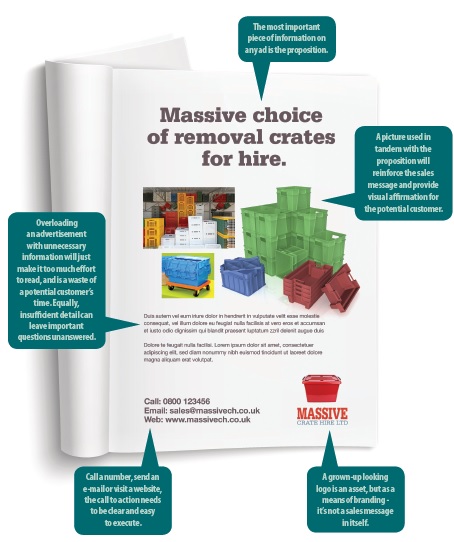All businesses need to market themselves, and even though new and innovative alternative marketing methods have emerged in recent years, press advertising remains an effective means of getting information about products and services in front of the right people. By Simon Taylor, freelance Graphic Designer.

There's a mantra in the advertising industry which says: 'products and services aren't sold, they're bought'. This makes the key point that in a competitive business environment, only those already looking to buy are worth targeting. Advertising is there to seek out potential customers who are already looking for what a company is offering, and to convince people to buy from them and not their competitors.
Communication is one of the key things that advertisers can get wrong. There are a handful of common mistakes that, when they are made, far from persuading a potential customer to take the vital step of contacting the advertiser, actually confuse, or even alienate them.
Unless the advertiser is a global brand, its logo will not sell its offering to anyone who has never dealt with it previously. A grown-up looking logo is an asset, but as a means of branding - it's not a sales message in itself. Positioning the company name front and centre is a mistake; the most important piece of information on any ad is the proposition.
The proposition is the core of every ad. Usually referred to as the headline, it's the key sentence or phrase that tells the reader what the advertiser is selling. If it achieves this in an engaging and memorable way, so much the better, but being too clever will just confuse the target audience. Many top brands have been built using creative and original headlines, but every last one had at its core a clear sales message. Getting the sales message right is the priority, wit can always be added later.
The most effective proposition is one that's unique to a single company. A unique selling proposition, or USP, is a feature of a company's offering that is of benefit to potential customers, but that none of its competitors can match. The lowest rates, or the most frequent scheduled runs to Eastern Europe, for example. If a company has a USP, then it has a ready-made sales message, and failing to communicate it without good reason could mean it's missing a trick.
A picture used in tandem with the proposition will reinforce the sales message and provide visual affirmation for the potential customer, but it needs to be relevant. For example, a crate hire company whose proposition centres on the variety of crates on offer could show images of the various crates available. An image of the exterior of its warehouse will not persuade anyone to hire crates.
A potential customer, having seen a proposition that is of interest, will want some details, but there's a potential pitfall for advertisers here, too. Overloading an advertisement with unnecessary information will just make it too much effort to read, and is a waste of a potential customer's time. Equally, insufficient detail can leave important questions unanswered. Getting the balance right is worth the time and effort.
Once the proposition and detail have convinced a potential customer to make an enquiry, a 'call to action' is required. This is the mechanism, or mechanisms, by which the advertiser wants the potential customer to enquire further. Call a number, send an e-mail or visit a website, the call to action needs to be clear and easy to execute, and providing the advertiser is set up to respond efficiently, a new sales lead may well be the result.
Concentrating on getting a few key things right is the key to realising the potential sales opportunity in a press ad, and maximising return on the investment made.
For more information e-mail: talk2ilike@btopenworld.com or visit www.ilike-creative.co.uk
Click here to view the next Editor's pick